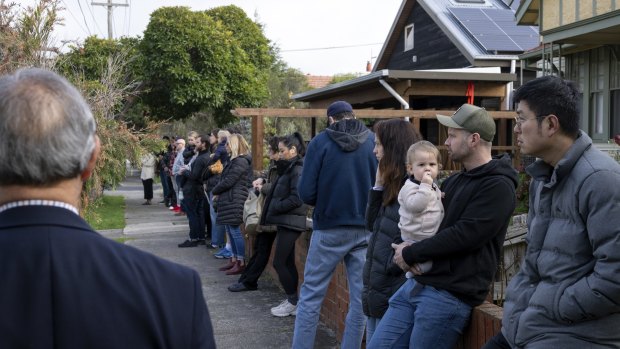This was published 10 months ago
Property investors are fleeing Victoria over soaring land taxes
By Josh Gordon
Housing investors are fleeing Victoria’s property market for states with lower taxes, raising doubts about the future supply of rental properties.
Figures released by the Australian Bureau of Statistics last week revealed that in April, just 30.6 per cent of all housing loans were taken out by investors following an exodus of property investors from Victoria.

Prospective home buyers at an auction in Brunswick on Saturday.Credit: Penny Stephens
That has prompted warnings from experts about a further squeeze on the supply of properties to let during the current rental crisis, with rents rising and fewer properties available.
In NSW in the same period, investors comprised 40.5 per cent of all housing loans, compared to 37.6 per cent in Queensland, 35.8 per cent in South Australia and 37 per cent in Western Australia.
But it’s not all bad news: the loss of property investors has been offset by first home buyers returning to the Melbourne market as prices continue to moderate compared to other capitals.
Of all property loans written in April, 24.9 per cent went to Victorian first home buyers who were buying a home to live in. That was by far the highest rate in the nation.
The first home buyer rate was just 18.2 per cent in NSW, 17.5 per cent in Queensland, 16.6 per cent in South Australia and 20.9 per cent in Western Australia.
The figures followed data from property monitoring business CoreLogic showing Melbourne is no longer the second most expensive city for houses. That title now goes to Brisbane, where the median house now costs $937,479 – $190 more than in Melbourne.
Over the year to May, house prices leapt 15.9 per cent in Brisbane, 10.3 per cent in Sydney, 25.3 per cent in Perth and 15.3 per cent in Adelaide. In Melbourne, house prices limped up by just 2.4 per cent over the year.
Property Investment Professionals of Australia chair Nicola McDougall said a huge number of investors had left Victoria – primarily because of the 2023 land tax increase for investors imposed by the state government, but also because of rising interest rates and other cost imposts.
“More than most other states, what we are seeing in Victoria is a raft of what investors perceive to be anti-investor policies … at a time of really high interest rates,” McDougall said.
“Fundamentally what that is doing is reducing the supply of rental properties, which is making the current rental crisis that we have around the nation and certainly in Victoria more entrenched and prolonged, and will see those rental increases continue for the foreseeable future.”
Vacancy rates in Melbourne have been at a record low of 0.8 per cent, according to Domain data from February. Median asking rents for houses had increased 14 per cent year on year to $570 a week in the March quarter, the latest Domain Rent Report said.
“From an affordability perspective, home values being flat or falling is actually good news,” said CoreLogic’s head of residential research, Eliza Owen. “The fact that Melbourne has now fallen below Brisbane could actually draw more people back.”
The state government announced what it called a COVID-19 debt levy in the 2023 state budget, clawing back an extra $4.7 billion from property investors over four years through higher land taxes.
It has also recently expanded its vacant residential land tax, adding an extra 1 per cent tax on residential land left undeveloped for more than five years in established areas of Melbourne. Tougher energy efficiency standards for rented homes are also on the cards from October 2025.
Economic research organisation e61 recently released a report showing Melburnians also face the biggest stamp duty impost in the nation, with the average home buyer is forced to shell out the equivalent of about six months of take-home income for a typical home – up from about two times at the turn of the millennium.
A survey by industry body Property Investments Professionals of Australia released in September found Victoria was, by a long margin, ranked as the least attractive state for housing investors in the nation.
It also found that 24.8 per cent of respondents sold at least one investment property in Melbourne in the 12 months to August last year – also the highest in the nation.
The state government has set a target to build an average of 80,000 houses a year for the next decade to help relieve pressure on the housing market, promising more density in existing suburbs rather than further expansion on the fringes.
Although the state built a record number of homes just before the pandemic derailed the state economy, more recently it hasn’t been building enough to even keep pace with rapid population growth, let alone place downward pressure on prices and rents.
Last year, for example, work started on just 53,711 houses, flats and townhouses, well below the annual target.
Get the day’s breaking news, entertainment ideas and a long read to enjoy. Sign up to receive our Evening Edition newsletter.